Gastroesophageal reflux - series
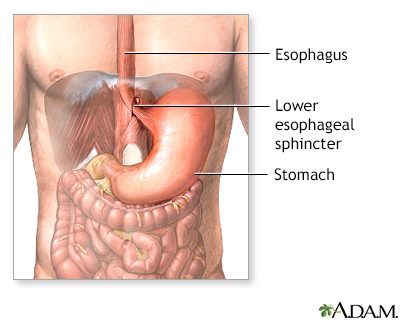
Normal anatomy
The esophagus is a narrow, muscular tube that leads from the mouth to the stomach. The esophagus carries food from the mouth to the stomach. A sphincter at the junction of the esophagus and the stomach prevents reflux of food and acid from the stomach into the esophagus.
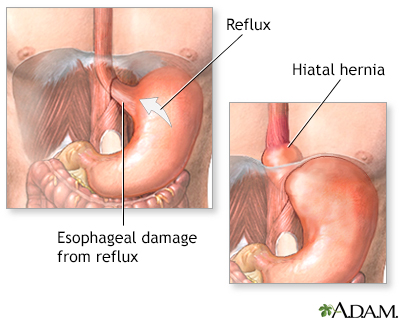
Indication
When the lower esophageal sphincter doesn't function properly, acid and food can reflux up from the stomach into the esophagus. This can lead to pain (heartburn) and damage to the lower esophagus. This damage can cause strictures (narrowing) of the esophagus, and eventually, cancer of the esophagus.
Frequently, dysfunction of the lower esophageal sphincter is associated with a hiatal hernia, in which the lower esophagus and upper part of the stomach slips up into the chest.
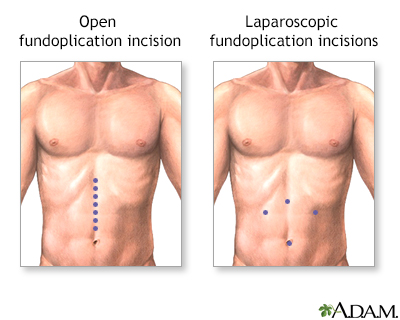
Incision
The first step in managing esophageal reflux disease involves medical treatment. Anti-acid medications can neutralize acid that refluxes into the esophagus and prevent damage to the esophagus. If these medications do not eliminate symptoms, surgery may be necessary.
The primary surgical treatment of esophageal reflux is called esophageal fundoplication. Fundoplication can be performed through an upper midline incision, or using a laparoscopic procedure.
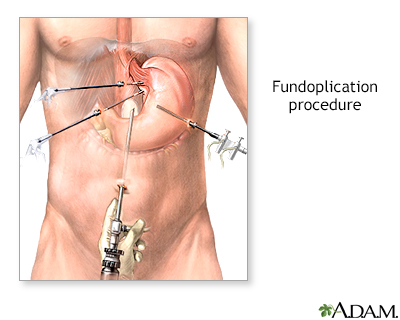
Procedure, part 1
Currently, the laparoscopic procedure is being performed more frequently. Long narrow instruments are passed through small incisions in the abdomen, and the surgery is viewed using a long narrow camera passed through one of these incisions.
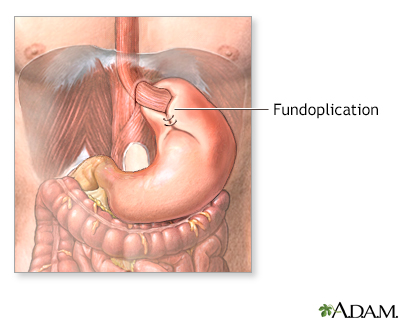
Procedure, part 2
There are a number of different types of fundoplication procedures, which all involve wrapping a part of the upper stomach around the esophagus and re-creating the lower esophageal sphincter.
The most commonly performed fundoplication procedure is called Nissen's fundoplication. Fundoplication generally has excellent results, and cures reflux disease without the need for life-long anti-acid medications.
BACK TO TOP
Review Date: 1/24/2025
Reviewed By: Jenifer K. Lehrer, MD, Gastroenterologist, Philadelphia, PA. Review provided by VeriMed Healthcare Network. Also reviewed by David C. Dugdale, MD, Medical Director, Brenda Conaway, Editorial Director, and the A.D.A.M. Editorial team.

Health Content Provider
06/01/2025
|
A.D.A.M., Inc. is accredited by URAC, for Health Content Provider (www.urac.org). URAC's accreditation program is an independent audit to verify that A.D.A.M. follows rigorous standards of quality and accountability. A.D.A.M. is among the first to achieve this important distinction for online health information and services. Learn more about A.D.A.M.'s editorial policy, editorial process and privacy policy. A.D.A.M. is also a founding member of Hi-Ethics. This site complied with the HONcode standard for trustworthy health information from 1995 to 2022, after which HON (Health On the Net, a not-for-profit organization that promoted transparent and reliable health information online) was discontinued. |
The information provided herein should not be used during any medical emergency or for the diagnosis or treatment of any medical condition. A licensed medical professional should be consulted for diagnosis and treatment of any and all medical conditions. Links to other sites are provided for information only -- they do not constitute endorsements of those other sites. © 1997- 2025 A.D.A.M., a business unit of Ebix, Inc. Any duplication or distribution of the information contained herein is strictly prohibited.
